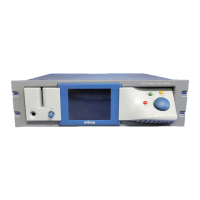3-60
OPERATION ORBAN Model 8400
Getting the Bass Sound You Want
Probably the most frequently asked question we get regarding 8400 setup is “How do I
get a (such-and-such) bass sound?” It seems that individual preference varies in this area
more than anywhere else.
There are no magic formulas. The 8400 has extremely versatile controls affecting bass
sound, and will allow you to get almost any sound you want as long as that sound re-
spects the laws of physics—or, in this case, the laws of psychoacoustics.
The ear is far less sensitive to bass than to midrange sounds. You can see this for yourself
by examining the classic Fletcher-Munson "equal-loudness" curves. This means that if
you want lots of bass, it’s going to take up a great deal of room in your modulation wave-
form. This room could otherwise be used for midrange, where far smaller amounts of
energy yield the same amount of loudness. Accordingly, there is an important tradeoff
between loudness and bass—if you want more bass, you will have to accept either less
loudness or noticeably more distortion, the distortion occurring when the bass waveforms
push the midrange and high frequency material into the 8400’s final clipper.
There is one psychoacoustic trick you can do to create more apparent bass while effi-
ciently using modulation headroom. For hundreds of years, pipe organ makers have
tricked the ear into hearing non-existent fundamental tones (which would require huge,
expensive pipes) by replacing them with several, smaller pipes tuned to the lower har-
monics of the missing fundamental. In the 8400, you can use the bass clipper to make
harmonic distortion for this purpose. As explained above, the bass clipper has three set-
tings—
Soft, Medium, and Hard—that determine the amount of distortion the clipper
makes when its clips bands 1 and 2.
Soft provides the purest sound, but Medium and Hard
create progressively more distortion on bass. Because
Hard can make noticeable voice
distortion, the factory programmers prefer
Medium for most presets. However, if you are
willing to trade off voice distortion against bass punch, then you could also use
Hard.
Hard is particularly effective in increasing bass punch because it flat-tops bass transients,
and this allows the waveform to accommodate fundamentals that have a larger peak level
(by up to 2 dB) than the peak level of the flat-top. (The fundamental of a square wave has
a peak level 2.1 dB higher than the peak level of the square wave.) In essence, by doing
this, your bass fundamentals can exceed 100% modulation without having the composite
stereo waveform itself exceed this level.
The attack time of the band 1 compressor also affects bass punch by determining the
amount of bass transient that is allowed to pass through the compressor before the attack
clamps down the rest of the waveform. Any transient that passes through the band 1
compressor will hit the bass clipper, so slower attack times on band 1 will increase bass
punch at the expense of distortion (particularly on voice). The
Band 1 Attack Time set-
tings in the factory presets have been adjusted with this tradeoff in mind, but you might
like to make a different one.
The threshold of the band 1 compressor will also affect bass punch. We recommend that
you carefully study the setting of this control (and the
Band 1 Attack Time control) in the

